“Stop the madness for constant group work. Just stop it!” pleads Susan Cain, author of Quiet: The Power of Introverts in a World That Can’t Stop Talking. Group work, she claims, stifles some of the most insightful and creative thinkers and inflates the influence of extroverts. To generate the best ideas, workplaces and schools need to provide more solitude for deep reflection and creative thinking.
As a facilitator, her critiques made me wonder. Do the group processes I use marginalize important voices and perspectives? Is it possible to design meetings and workshops to fully involve introverted participants? I started a conversation around these questions with fellow facilitator Margaret Sullivan and together we designed a workshop to test our ideas and learn from others.
This blog summarizes learning from our “Facilitating Introverts” workshop held May 16, 2014 with the International Association of Facilitators (IAF), Chicago chapter. We warmly invite additional suggestions (use “Leave A Reply” below) for how to include introverts in meetings and workshops!
What’s an introvert?
The concept of introversion originated with psychologist Carl Jung who noticed that people tend to be energized either by going inward in quiet reflection (introverts) or outward in interactions with people (extroverts). Later personality theorists added concepts like how one processes information, sensitivity to novelty and stimulation, and attitudes toward privacy and public attention.
Introversion/extroversion is a spectrum (see top photo). The population is roughly equally divided between the two halves and most people fall somewhere toward the middle. Although most people can function in both introverted and extroverted ways, they prefer one or the other. So, traditional group work, which is designed for extroverts, can indeed disadvantage introverts. To rectify this imbalance, it is necessary to first understand the special needs and gifts of introverts.
Importantly, since nobody functions exclusively as an introvert or extrovert, it would in fact be more accurate to discuss facilitating introversion or incorporating introverted processes into group work. This however is linguistically and conceptually cumbersome. So, for clarity, we simply use the term “introverts”.
Needs and gifts of introverts
Reflecting on the ideas of personality theorists and considering group situations that challenge introverts, we created a list of needs and gifts of introverts (click here, open with Adobe Reader) relevant to group work.
Important themes include:
• Managing energy. Introverts are drained by social interaction and need alone time to recharge.
• Processing time. Introverts take in lots of multi-layered information. They may therefore need more time than extroverts to process information, reflect, and decide what to say. They also need to understand expectations so they may prepare in advance.
• Privacy and caution. Introverts do not like to call attention to themselves and can be reticent to share their ideas — especially if they are not yet fully formed or may provoke conflict.
• Meaning and focus. Introverts are drawn to meaningful conversations and can go deep into subjects. Conversely, they get overwhelmed when multiple themes are discussed simultaneously.
• Deep listening. Introverts can be very attentive listeners. They may notice things and make connections that extroverts miss. They also ask great questions.
• Writing and non-verbal expression. Many introverts prefer to communicate in ways other than talking and may be skilled at writing or drawing.
• Creativity and imagination. Introverts have rich inner lives which can lead them to uncover valuable insights and generate creative solutions.
Tools and techniques to involve introverts
Using these needs and gifts, we brainstormed tools and techniques to help introverts feel comfortable, meet their needs, and share their gifts in group work. We then added ideas culled from online facilitator forums and workshop discussions. We offer this initial list of tools and techniques for facilitating introverts (click here, open with Adobe Reader) to facilitators as thought-starters in designing group processes.
An introvert-friendly workshop
To demonstrate what an “introvert-friendly” workshop might look like, the methods we used in our own “Facilitating Introverts” workshop and why we chose them are described below.
I. Arrival and Dinner
Arriving at a meeting or workshop can be uncomfortable for introverts, especially if they don’t know anyone. So it’s important to consciously design an experience to put them at ease. We provided:
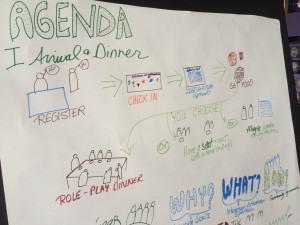 Visible agenda. Introverts like to know what to expect, including when they may need to contribute. We displayed a large visual agenda at arrival and reviewed it at the start of the workshop.
Visible agenda. Introverts like to know what to expect, including when they may need to contribute. We displayed a large visual agenda at arrival and reviewed it at the start of the workshop.
Greeter and host. While extroverts can just dive into unstructured social situations, introverts welcome some assistance. Participants were met by a greeter at a registration table and a “host” who mingled and made sure everyone was comfortable – e.g., introducing people and suggesting activities.
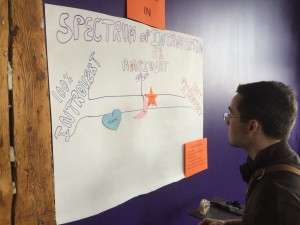 Nonverbal check-in. Fun, non-verbal activities done at one’s own pace can be an easy warm-up and help facilitate connections. We invited participants to write their mood on a colored shape and place it on an introversion-extroversion spectrum chart. This also introduced a core concept of our workshop, showed who was in the room, and provided a “temperature check”.
Nonverbal check-in. Fun, non-verbal activities done at one’s own pace can be an easy warm-up and help facilitate connections. We invited participants to write their mood on a colored shape and place it on an introversion-extroversion spectrum chart. This also introduced a core concept of our workshop, showed who was in the room, and provided a “temperature check”.
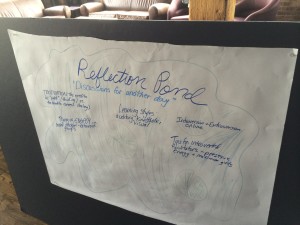 Reflection pond. This served as both “graffiti wall” and “parking lot”. Introverts don’t like to draw attention to themselves or provoke conflict so it’s good to offer ways to share anonymously. They can also get overwhelmed when multiple topics are discussed simultaneously. So it’s useful to use methods like “parking lots” to keep conversations focused.
Reflection pond. This served as both “graffiti wall” and “parking lot”. Introverts don’t like to draw attention to themselves or provoke conflict so it’s good to offer ways to share anonymously. They can also get overwhelmed when multiple topics are discussed simultaneously. So it’s useful to use methods like “parking lots” to keep conversations focused.
Dinner choices. It’s important to never label a person or activity as “introvert” or “extrovert”, but rather to offer choices that allow participants to manage their own energy. For dinner, we offered three options: mingling informally, sitting in small groups, or participating in a facilitated “role play” game. We also kept novelty and stimulation low by providing familiar food (pizza) and calming music.
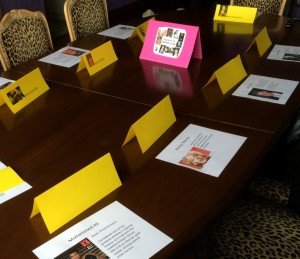 Role play dinner. Since introverts may be reticent to draw attention to themselves, role play games can help them speak more freely. We created a scenario where five famous introverts and five famous extroverts worked together on a project team. Participants described how their character (e.g., Eleanor Roosevelt, Marie Antoinette, etc.) would feel and behave in different group situations. This provided both structured group interaction and a playful introduction to workshop themes.
Role play dinner. Since introverts may be reticent to draw attention to themselves, role play games can help them speak more freely. We created a scenario where five famous introverts and five famous extroverts worked together on a project team. Participants described how their character (e.g., Eleanor Roosevelt, Marie Antoinette, etc.) would feel and behave in different group situations. This provided both structured group interaction and a playful introduction to workshop themes.
Flexible meeting space. We chose a meeting space, the Thinkubator, that provides many seating options, nooks and crannies, and an outdoor deck for different types of group interaction and solo breaks.
II. Opening
After introducing the topic, we created community agreements that included:
• Mo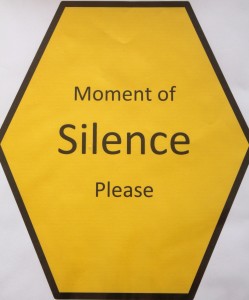 ment of silence. Because introverts take in so much information, they sometimes need extra time to “catch up”. To create opportunities for this, we created “silence” signs anyone could use to request the group to be quiet for a few minutes – no explanation needed.
ment of silence. Because introverts take in so much information, they sometimes need extra time to “catch up”. To create opportunities for this, we created “silence” signs anyone could use to request the group to be quiet for a few minutes – no explanation needed.
• Breaks. Introverts sometimes need alone time to recharge. So we gave participants permission to take a break at any time, for any reason, no questions asked.
• OK to pass. Introverts sometimes need additional time to formulate their thoughts. So, in structured go-arounds and sharing times, participants can “pass” and talk later.
• Don’t hold back. “Quieter people” were reminded that they too have contributions valuable to the group and not to “hold back” sharing.
Homework and paired sharing. Introverts like to come prepared to meetings. Assigning homework is one way to achieve this. We asked participants to watch Susan Cain’s TED Talk to prepare. The first social interaction was low-key: sharing one thing learned from this video with one’s neighbor.
III. Needs and Gifts
An individual “scenario reflection” exercise was used to identify introverts’ needs and gifts. Three situations were described that can be challenging to introverts: 1) arriving at a meeting of strangers, 2) being asked to share one’s viewpoint early in a meeting, and 3) a meeting on a contentious issue. To share ideas, we planned a structured go-around using a talking stick. This gives introverts the floor without them having to ask for it, but also lets them “pass” and speak later if they aren’t ready to talk.
IV. Tools and Techniques
We began with individual brainstorming, followed by a 20 minute discussion in groups of 3-4 people to modify and add to our initial list of tools and techniques. Especially with introverts, it’s important to begin brainstorming individually. A group size of 3-4 people allows sharing, but is comfortable to introverts.
Here’s a 1 minute video of the entire workshop (thanks to Gerald and Steve at the Thinkubator):
V. Post-event
Introverts often get their best ideas after a meeting or workshop – i.e., once they’ve had time to fully process its content and reflect alone on its meaning. So it’s important to provide a method, such as an online forum, to continue sharing and discussion after the event. That is one goal of this blog.
What do you think?
Margaret and I are sharing this blog with both the Chicago IAF workshop participants and the broader facilitation community. We invite suggestions of additional tools and techniques, needs and gifts, and thoughts on “facilitating introverts”. Please leave your comments below in “Leave A Reply”. You may also post a comment on the Chicago IAF Facebook page or Linked In group.
If there is sufficient interest, we might offer this workshop again, perhaps in modified or expanded form. Please use the contact form to let me know of your interest in organizing or assisting with a future workshop.
Photos: Al Rush
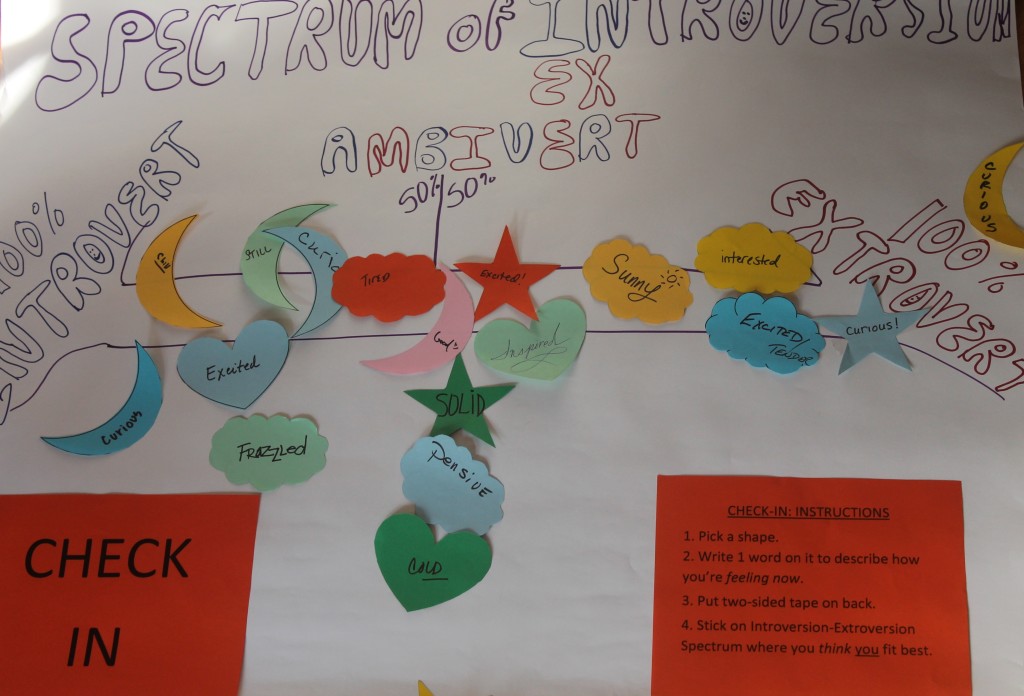
Thanks for sharing and inviting others to offer ideas.
I first learned about Susan Cain in May 2012 while reading a review of the Avengers movie. I wrote this blog article following that. http://tutormentor.blogspot.com/2012/05/avengers-leadership-teams-introverts.html
One of the links I pointed to was an article titled ‘Want To Be A Leader? ‘Learn To Be Alone With Your Thoughts’ in which William Deresiewicz, “Speaking to a plebe class at West Point, said that without solitude, it’s hard to arrive at thoughts that are your own, and hard to develop the moral compass and moral courage necessary to act on those thoughts.”
Another article I pointed to was Malcolm Gladwell article talking about the 10,000 hours it takes for a person to become an expert in any subject.
I think that there is so much information available to help people learn about social, economic, health problems in Chicago and the world that few people actually dig deep into this information (10,000 hours?) and who bring deeper learning into face to face meetings and networking events. Thus there is a lot of ‘reinventing of the wheel’ and many groups are focusing on the same problem, but in different meetings.
I’m an introvert myself. I do best in on-line communities where I am more comfortable sharing my ideas, and with blogs where I can post my own thinking. I would love to find people in business, philanthropy, religion, politics who were “introverts” like myself, and who share a passion for the same goals. Connecting with such people in on-line communities, such as MOOCs hosted by groups like the Connected Learning MOOC coming up in June, can help us build relationships that we can build on when we do find time to meet in face to face events.
Thanks Dan for sharing those thoughts and links! You make an important point regarding integrating research learning and data into discussions. This is actually a hot research topic in the field of deliberative democracy — i.e., how to give the public enough information on an issue so they can discuss it intelligently but not be overwhelmed.
Perhaps this might be a good use for “homework” or online forums that start before and continue after face-to-face gatherings. Another approach could be the iterative “meet – reflect/research – meet – reflect”. All this requires good synthesis skills to focus only on the most important information.
This is a very big question which extends beyond the topic of introversion — perhaps something to explore in a future workshop.
Janice, if more people were looking at the information already available they would expand their understanding of the problem, and have more ideas to stimulate their involvement in solutions. Instead of reinventing the wheel, this could lead to constant improvement of civic engagement.
For this to happen, some people need to be collecting and organizing information. This strategy map shows that information gathering is the first of four concurrent actions that should result from this process. http://tinyurl.com/TMI-4-Pt-Strategy This PDF is an explanation of the 4-part strategy. http://tinyurl.com/TMI-4-part-strategy-pdf
While I collect information related to poverty and youth, I point to nearly 2000 other organizations who have greater expertise, and point to more people and ideas than I do. Most don’t point back to me and few of us are connected on any type of social media, or in place-based events.
As more facilitators draw from these information libraries they will be the glue that helps people and organizations in the library to connect more with each other.
Pingback: NCDD Community News » Facilitating & Introversion: Tips for Engaging Quiet People
Interesting article. It appears that these are extroverted ideas of what introverted people may like. For instance, as an introvert, words like “fun, non-verbal activities” and “role-play” make me want to scream. I would be fine with just being provided an agenda/information (with sufficient detail so I can think on and be prepared to talk about topics) in advance of the workshop and being provided contact information for the host/hostess in case I have questions before the workshop. I think training extroverts to listen and to respect well thought-out questions and deep discussion is just as important as trying to accommodate introverted needs. Thanks for the article.
Good comment, Michelle
I agree with much that this article says about intraverts and find some of the suggested techniques (such as use of host and greeter) interesting. I also like the posting that Daniel Bassill made. And finally, do agree with Michelle that saying things like “fun, non-verbal activities” and “role-play” were a bit off putting.
As a project manager, I hold several meetings a week and have learned to manage them based on a few points I learned from a Myers Briggs personality session. Extraverts think out loud and need opportunity to openly explore ideas, their open conversations spur the thinking of intraverts who can develop the ideas to a deeper level. The meeting facilitator needs to deliberately intervene in the discussion and ask intraverts their thoughts before the extraverts drift onto another topic. Keeping meetings structured helps keep extraverts from running out the clock and provide intraverts focal points for discussion.
Conference calls seem to becoming more the norm than face to face meetings. Combination formats (call-in and face-to-face) can be tricky as the people who call in to a conference room tend to be on the fringes of conversation. I’ve seen meetings lose control when the extraverts in the room take conversations down unplanned paths while the facilitator, who is on the phone, struggles to take charge and the introverts on the phone stay silent.
Thanks Michelle and Chet for the thoughtful comments and suggestions!
This was just the start of a “learning journey” to explore introversion/extroversion in groups. The more we get into, the more complex it becomes. If we were to do this again, we’d probably frame the question differently (i.e., “introversion” vs. “introverts”). I’d definitely want to look at the issue you raised Chet of balancing the gifts/needs of extroverts and introverts and your point Michelle on teaching extroverts to use and value introverted approaches.
This first workshop was a combination of best guesses and open questions. The role play game was optional and was one of three choices for how to spend dinner. It worked well as a pedagogical device: people who played characters different from themselves learned the most (i.e., extroverts playing introverts and vice versa). Our open question was who would join: introverts or extroverts? The answer was both, although more introverts. The most extroverted participants seemed to prefer to mingle.
I’m curious about your reaction to the non-verbal check-in. Was it just the adjective “fun” that was the problem? Or something else? It seemed to work well, although several people suggested using it in a short face-to-face ice-breaker to value the diversity in the room.
This blog was shared on http://www.ncdd.org and picked up by http://www.govloop.com. It elicited some thoughtful comments and suggestions: http://www.govloop.com/profiles/blogs/facilitating-introversion-tips-for-engaging-quiet-people?elq=1a28a8b00a944e1a82c4216e6cdc9930&elqCampaignId=4672
I thoroughly enjoyed your blog post. Unfortunately, I was unable to attend the workshop. The book is on my “reading list” and based on this discussion it will move to the top! Thanks for your detailed review and insightful comments.
My excuses for my language, I’m a Dutchwoman. I hope I haven’t made unintentional insults 😉 The Dutch, like the Americans, are quite an extravert people. And the Dutch can be quite blunt, we don’t wrap up comments in nice phrases, we just utter them.
As an “ambivert” (at least I guess so) workshop facilitator I was trying to devise an “introvert-friendly” workshop myself when I found your article (via Susan Cains website). So nice to read!
Some remarks from my own experience as a facilitator:
I can imagine that a structured approach to meeting the other participants can also be realised by providing “conversation-starter-cards”. Role-playing can be quite frightening, allthough it gives structure. (But hey, that might be the HSP talking.)
To my experience, participants don’t need to know exactly what you are going to do, if you can at least tell them what kind of thing it is they will be doing. F.i. “we are going to use an individual ideagenerating technique” vs. “we are going to use the 6-3-5 approach, which is etc.”. And much depends on the facilitators: using humour and keeping a good eye to everyones needs can ease groups and individuals into unexpected situations without having people cross their personal boundaries.
Not everything has to be explicit, I peronally would shy out of answering when addressed as “the one who hasn’t spoken so far”… Just ask; “Femke?” and if I’ve got anything to say I will. Making eye-contact sometimes is quite enough to invite answers or to check whether people are still thinking, wanting to speak of being ready answering.
My line of thinking would be to devise a kind of “slow brainstorming”: I imagine a series of meetings, like Janice suggested in her reaction to Dan’s comment, but with individual assignments between them to keep the process afloat.
I love your list of tools and techniques. I guess electronic brainstorming can be added, but that’s a totally different kind of thing.
And wouldn’t is be wonderfull to have a workshop in total silence? As an experiment?
Pingback: Introvert workshoppen | Nieuwe Muze
A friend sent me this. It is very useful for me because I run monthly networking meetings for introverts. Thanks!
Here’s an interesting comment on this post left on the NCDD blog.
Lefty says:
September 21, 2014 at 3:27 pm
I enjoyed your article. 🙂
As an extremely introverted person who spent a career in a profession dominated by extroverts, I do have a perspective to contribute. The common perception of introverts is that we do not like to be the center of attention. While that is true to some extent, it is not the whole truth. I would suggest that there is a more accurate way to explain of our personality type. Some introverts are shy and some experience serious emotional distress, including Social Anxiety Disorder. However, for many introverts, particularly those of us who have adapted to a fast-paced, competitive work environment, being the center of attention is not necessarily problematic. It generally becomes distasteful for us, in my experience, in these sets of circumstances:
1. When we are suddenly thrust into the spotlight;
2. When we are thrust into the spotlight without our prior consent; and
3. When we are thrust into the spotlight feeling unprepared.
You may find that an introvert who has had advance warning, who has given his or her prior consent and who has had plenty of time to prepare thoughtfully and thoroughly can be one of the most compelling public speakers you have ever heard.
I certainly intend no criticism of your approach; rather, I thought that your view could perhaps be expanded a bit.
Lefty